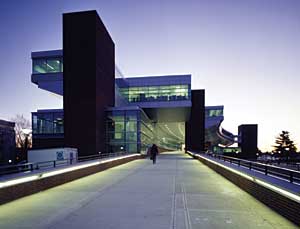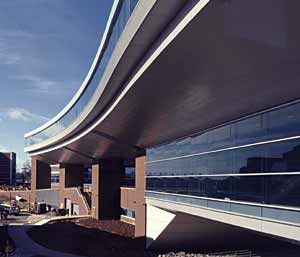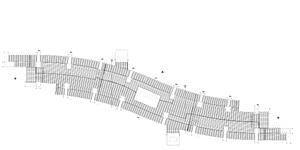Perforated Metal and Wood Ceilings: Sustainability, Acoustics, and Aesthetics
Raising the standards for acoustical performance and design flexibility
This course is no longer active
Michael Chusid, RA, FCSI
|
Penn State Building Uses Unique
Panel System |
|
Penn State University's new Information
Sciences and Technology Building demonstrates
that metal ceiling panels can deliver unprecedented
precision and customization yet still remain affordable.
An S-curve in the building's plan requires
panels that appear to curve, an effect heightened
by cantilevered, sloping soffits. The shimmering
metal soffit and ceiling panels are contiguous,
creating a visually continuous sweep across the
102 foot width of the building. Designed by Rafael
Vinoly Architects, the 680 foot long sinusoidal
ribbon of ceiling is the building's dominant
visual element.

Exterior
from End:
Photo Credit Rafael Vinoly Architects
Custom fabricated ceiling and
soffit panels appear to flow around
curves of building and to form
a "hull" from one side
of the building to the other. |
|
|
As the building houses an incubator for the advancement
of computerization, it is only appropriate that
the ceilings in the project were produced with
newly hatched computerized design and manufacturing
techniques. Each of the project's 7,500 panels
had to be fabricated in a different size. Calculating
the dimensions of the system was "intensely
mathematical" says Al Kiechle, senior project
engineer at Ceilings Plus, the Los Angeles-based
ceiling fabricator. Panels are tapered on both
ends and the dimensions of the inclined soffit
panels had to be calculated in three dimensions.
They vary from 72.6037" in length at the
outside curves of the building to 63.2844"
on the inside edge of the building's curves.
Kiechle says, "With conventional metal forming
techniques, we couldn't even measure panels
with this degree of precision." Instead,
Ceilings Plus used automated high-speed, precision
CAD/CAM punch presses and brake forms. "This
enabled us to fabricate components with a tolerance
measured in ten-thousandths of an inch. The differences
were minute, but an error in even one panel would
have appeared as a flaw in the geometry of the
building." Kiechle says.

Exterior
from Side:
Photo Credit Rafael Vinoly Architects
Metal exterior soffits required
were individually fabricated to
meet the building's geometry
and resist strong winds and thermal
movement. |
|
|
For acoustical control, interior panels have
perforations and a non-woven acoustical fabric
to create a noise reduction coefficient (NRC)
of .75. The factory installed acoustical fabric
is gray to match the panel color and reinforce
the monolithic appearance of the "inside-outside"
plane. Stainless steel torsion springs allow 100%
access to the cavity above the ceiling to permit
easy access to cables and ductwork serving the
computer labs located on the top level.

Reflected
Ceiling Plan:
Photo Credit Ceilings Plus
Special software was used to convert
the architects' digital drawing
files into a format that could
be read by numerically-controlled
perforating and metal-forming
equipment, significantly reducing
the time and costs required for
CAD/CAM fabrication of panels
for the project. |
|
|
|
|
Originally published in Architectural Record.
Originally published in July 2009